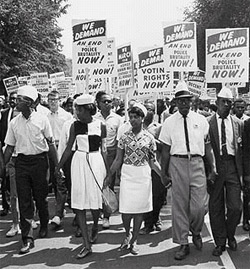Sep 4, 2008
 It was a warm spring afternoon when Martin Luther King addressed tens of thousands gathered in front of the Lincoln Memorial, the largest gathering to date in the growing struggle for civil rights.
It was a warm spring afternoon when Martin Luther King addressed tens of thousands gathered in front of the Lincoln Memorial, the largest gathering to date in the growing struggle for civil rights.
King rallied the crowd with his stirring refrain: "Give us the ballot!" He called for the government, white liberals, white Southerners, and finally the African-American [...]
Read the Full Article

Already a subscriber? Login